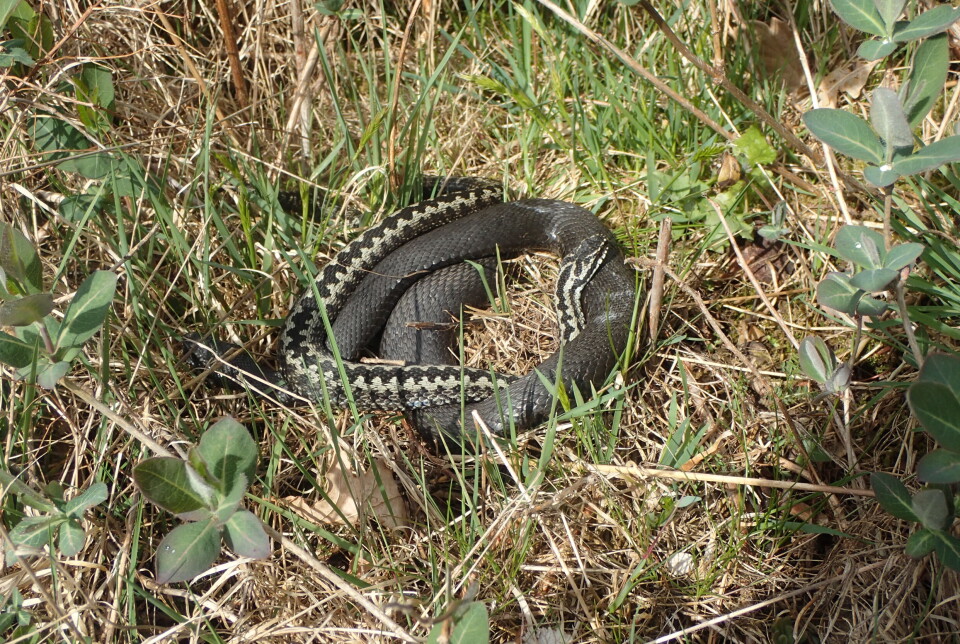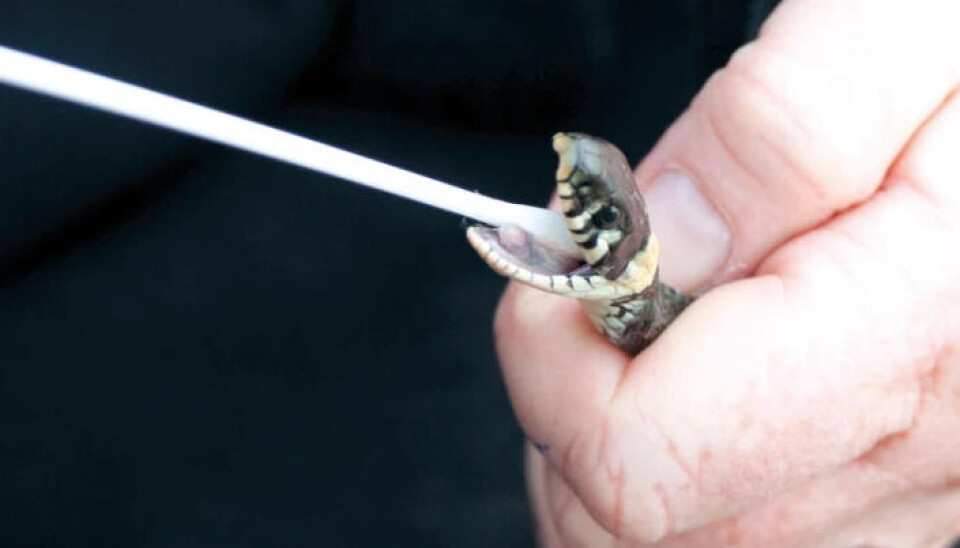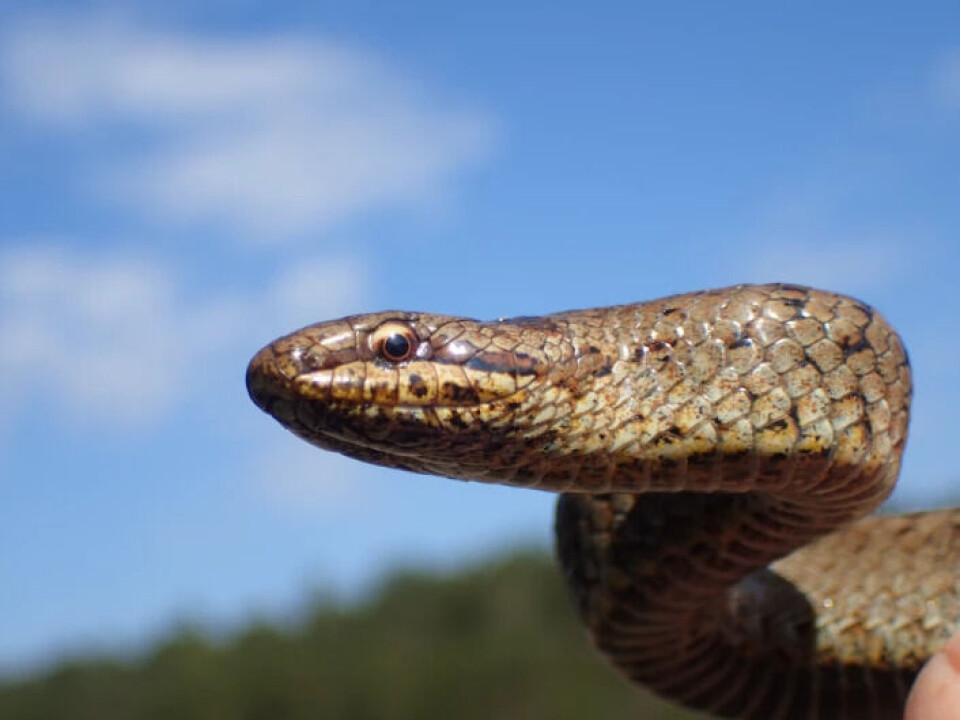THIS ARTICLE/PRESS RELEASE IS PAID FOR AND PRESENTED BY THE University of Agder - read more

The viper has been outside maturing its sperm since February
The male viper is out early to get ready for the females. Zoologist Beate S. Johansen is actually out looking for the smooth snake, the shyest snake in Norway.
Nature doesn't wake up in spring. It has been awake all winter, according to zoologist and snake expert Beate Strøm Johansen at the University of Agder Natural History Museum and Botanical Garden.
Even the snakes, which according to encyclopedias should lie dormant from around September to April, have not stayed inside, in hibernation.
Some of them awoke already in February.
In dry grass and heather, the researcher found them wide awake. The vipers lay in the sun, warming their sperm.

Getting ready for mating
The male viper has arrived in good time, while the female viper is still dormant in underground passages.
“The viper’s sperm is maturing,” Johansen says.
The male viper must have mature sperm before mating.

Warmer on the ground
It can be up to 20 degrees in tufts of grass and ling when the sun is shining in February. The researcher used a handheld infrared thermometer to measure both the temperature of the viper and the ground. She measured 18 degrees in February.
Johansen also measures weather and light conditions, with a handheld light meter. And she inserts a stick into the mouth of as many smooth snakes as she can. She takes DNA samples, and measures their length and weight.
She takes DNA samples from vipers too, but uses a different method. She takes samples from snake skins that she finds. Snakes shed their skin twice over the summer.

Smooth snake, the constrictor
It is the smooth snake (Coronella austriaca) that the zoologist looks for when she is out searching for snakes. But snakes tend to stay in the same areas, whether they are smooth snakes, vipers or grass snakes. They are protected animals and illegal to kill.
Areas with bushes and shrubs, holes in the ground, heaths, bogs and stone piles are ideal for snakes. They thrive in locations where they can quickly escape and hide.
Snakes are secretive. Even when they are completely alert, they tend to lie still or crawl slowly, rather soundlessly, hiding beneath heath and shrubs. They are also sedentary. They like to stay 3-400 metres from their wintering dens. If you see a snake, you can be fairly certain that there are several more in the area.
Searching for smooth snakes is Johansen's favourite pastime. But the researcher documents grass snakes and vipers too, although she does not have time to document all the species of snakes equally thoroughly.
A battalion of smooth snakes
Johansen knows how many smooth snakes there are in Møvik, the old military area in Vågsbygd, 10-15 kilometres outside the centre of Kristiansand.
She has photographed and counted every single one. Everything has been recorded in a small field notebook. Afterwards, the notes are typed into a document on the computer. It says that 175 smooth snakes have been in Møvik during the past four years.
You could call that a battalion of smooth snakes in the old military area. With that, Møvik holds the Norwegian record for the number of smooth snakes.
The big ones eat the little ones
The area is well suited for snakes. Grass snakes, slow worms and vipers live in the same area, admittedly not close to each other.
“The smooth snake can easily eat smaller vipers and grass snakes, so life is not entirely risk-free out there,” Johansen says.
The zoologist can reveal that a lot is going on among these snakes. One of her students just found the remains of a smooth snake in the stomach of another smooth snake.
The snake researcher has no evidence that the smooth snake engages extensively in cannibalism. It could be by chance that the snake ate one of its own kind, but it could also be due to fighting over a mate or extreme hunger. Normally it eats slow worms, shrews, voles and lizards.
The smooth snake is a constrictor, harmless to humans but deadly to the tiny grass snake, which slowly loses its breath as it is suffocated by the smooth snake.
A larger grass snake can also eat a smaller smooth snake. In general, being small is not safe. It is best to be large in size.
“The bigger snakes have little to fear from other snakes, but a small viper, grass snake or smooth snake can easily be eaten by larger snakes,” says Johansen.

The most secretive snake
The smooth snake lives a hidden existence under rocks and among low vegetation. It is considered the most difficult snake species in Europe to study.
More is known about them now. Johansen started a research project on the biology of smooth snakes in 2018. Since then, she has presented several papers on the snake.
Now we know, among other things, that the smooth snake robs birds’ nests. It mates many times a year. We know what it eats, and we know how many there are. Johansen has also improved the map that shows the distribution of smooth snakes in Norway.
Both the species map in the Species Map Service database and the Species Observations reporting have improved. She has entered 513 smooth snake observations in the coastal zone from Oslo Fjord to Southern Norway on the species map, in addition to the 175 observations from Møvik.
The male viper has been moving back and forth between the heather tussocks outside and its underground passages since February. But in April, both male and female vipers, grass snakes, and smooth snakes come out to warm themselves in the spring sun.
References:
Johansen et al. Mating activity and parturition of the smooth snake Coronella austriaca in Norway, The Herpetological Bulletin, vol. 160, 2022. DOI: 10.33256/hb160.1318
Johansen, B.S. & Flaatten, Ø. Oophagy in the Smooth snake Coronella austriaca – first photographic record of bird egg predation, The Herpetological Bulletin, vol. 157, 2021. DOI: 10.33256/hb157.3536

This article/press release is paid for and presented by the University of Agder
This content is created by the University of Agder's communication staff, who use this platform to communicate science and share results from research with the public. The University of Agder is one of more than 80 owners of ScienceNorway.no. Read more here.
See more content from the University of Agder:
-
Research paved the way for better maths courses for multicultural student teachers
-
The law protects the students. What about the teachers?
-
This researcher has helped more economics students pass their maths exams
-
There are many cases of fathers and sons both reaching elite level in football. Why is that?
-
How we used plants to protect ourselves from evil
-
What is it like for nurses to promote health behind bars?




































